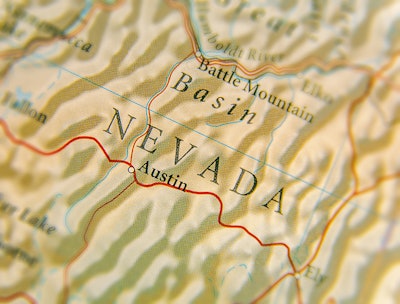
Since Nevada began legal recreational marijuana sales on July 1, ongoing distribution issues and record sales have led to a 200-percent increase in marijuana prices. Ben Horner, general manager of Friday Night Inc., a Canadian cultivator whose Alternative Medicine Association (AMA) subsidiary is located in Las Vegas, and Mark Zobrist, managing partner of AMA, point to a shortage of supply to meet the increased demand and high taxes as major factors in the rising prices.
“All the other cultivations in town that I’ve talked to are definitely selling as fast as they can grow it, so it’s a race to expand right now and get that product to shelves,” Horner said in an interview with Cannabis Business Times. “The taxes that the state’s imposed on the flowers, pre-rolls and trim is also keeping the costs high, much higher than normal.”
“It’s available for recreational use now, so you do not have to have a medical card, which creates a much bigger population that can use the product,” Zobrist said. “The demand is … higher, and whenever you have higher demand and lower supply, you’re going to have increasing prices.”
In an interview with Cannabis Business Times, Geoff Doran, co-founder and vice president of business development at Colorado-based online cannabis wholesale platform Tradiv, offers additional insight on the state’s cannabis-related economic issues, providing tips on how both businesses and other states can avoid a similar situation in their markets.
Cannabis Business Times: What factors have led to this extreme marijuana price increase in Nevada’s market?
Geoff Doran: There [are] quite a bit of factors playing into this, and it’s nothing that Nevada, as a state, did. … I have to give them a lot of credit. They really fast-tracked the [adult-use] program in their state, which is something to be applauded. …
[Nevada has] had some issues with figuring out … logistics … or their supply chain, but I don’t think [logistics are] a major factor on why the price probably went soaring all the way up to $2,800 to $3,200 per pound. It’s certainly something to note that without a true distribution model in place right from launch, it’s going to be … hard to get the product from point A to point B. And if it’s not figured out, it’s going to cause some trip-ups. … [But] I see the transportation problem being a small percentage of the problem. Of course, there is a major need for transportation as we know first-hand here in Colorado, but there are other major factors to add into the equation. The first one is the lack of solid data to base very accurate analytical decisions on because we have an industry coming out of the shadows to the light.
Without solid information, the regulators have a tough job deciding on how many cultivation licenses they should hand out. There lies the problem with most states. It's really hard to decide whether to set a limit on cultivation licenses or … have what I like, which is a true open market and let Mr. Market create the correct amount of inventory for the demand.
I also think that as a country we're very naive about the amount of true cannabis consumers there really are out there. With that said, I think the regulators and the industry misjudged the plant count/licenses. The other factor is that, you have a lot of the growers who may have moved from a basement grow to scaling to 10,000, 20,000 and more square feet. This major change takes a little bit of time to dial in the yields and processes to bring the proper amount of cannabis to the consumers.
Unfortunately, it's a perfect storm of distribution issues and probably yield shortages. It's hard to expect a grower that just moved into a new building … to bring a perfect grow to the world. That's basically like asking an athlete to get to the competition, put their uniforms on and immediately start playing without zero warm up.
CBT: How have the rising prices been affecting producers and retailers?
GD: For the dispensaries, it’s got to be a big pain because at the end of the day, we all work for the consumer. … Also, the beauty of cannabis is that there’s also the wellness factor. So there are patients out there, and it’s got to hurt the dispensaries when they have to bring up the prices just because [they] may have to pay $2,800 to $3,200 per pound. Most of them are small- to medium-sized businesses, so they probably don’t want to pass that buck on to the consumer or patient, but a lot of times, it’s a matter of survival for some of these businesses because they’re just getting up and going, so they don’t have a lot of reserves to lean on when prices are fluctuating like they do in cannabis. …
On the cultivation side, it’s got to be a pain because … they know that they have the sales there, and they want to get the price … and they know that they could really be helping and fulfilling orders. But they also have to work against getting it there with the distribution problem going on right now.
… It’s just that the supply chain has not been filled out and so that’s got to hurt on both sides, whether you’re a cultivator or a dispensary.
CBT: Can anything be done to alleviate the rising prices?
GD: I think so. … I think it’s just a matter of sitting down at the drawing board again and saying, “OK , let’s look at the gaps that need to be filled. Let’s look at the foot traffic, and really do a true economical study on the dispensaries.”
The state of Nevada has a really unique … tourist season, just like California would have and Colorado has, in the wintertime and in the summertime. What would alleviate the situation would be for the regulators to roll up their sleeves, meet with a lot of these cultivators, meet with the dispensaries, and see how many more plant counts they can add [for] the current cultivators. Maybe it’s opening up 20 to 50 … new cultivation licenses. … But again, it’s not one of those immediate solutions because the cycle for cannabis takes three months for a full grow. …
CBT: What other obstacles, besides the rising price of marijuana, do producers and retailers in Nevada currently face?
GD: I think the one main issue right now is obviously they have a distribution/transportation issue that needs to be solved immediately. …
But the other one that I don’t think a lot of people think about is that different climates are going to affect … some of the cultivators. And to give you an example of what I mean, for instance, there’s been kind of a lull in the medical market in the last few weeks here in Colorado, and just talking to a lot of our cultivators and talking to a lot of people in the industry, … one of the factors that we’re seeing, and I think this is probably what they see in Nevada, is that in the summertime, the cost of HVAC or just airflow is going to go up because it’s hotter on the outside.
And so I imagine with Nevada, we just got out of the summer, and they probably had lesser yields. They’ll probably have a little more coming up in the wintertime, because it’s less cost to cool the entire facility. And if you have a facility at 10,000 square feet and in the middle of the desert, it’s going to cost a lot of money, along with water issues. I think those are some of the issues that Nevada’s probably facing right now, … just the electricity, water and proper airflow. So [if climate isn’t perfectly regulated due to costs], that brings down the yields, … not significantly, but it does bring down yields in the summertime. I think those are a couple of those issues, along with just growing pains . …
CBT: Can you compare this to a situation you have seen in another state and tell me how that state resolved the issues?
GD: ... We’re a mature market here in Colorado, but we’re still seeing … a distribution problem here in Colorado. … Not as bad as Nevada, but two weeks ago there was only one courier operating, and … to alleviate that situation, the regulators really jumped on it fast, and they were reviewing as many licenses and applications as they [could]. …
Just like anything in life, communication is everything, and when a law is passed, the regulators really have a tall order to make sure that every participant and applicant knows what needs to be done in order to be an up-and-running business because what happened with the couriers is … they had a whole year to plan, and only one had all the proper paperwork together … that goes with the transportation license, and so you really can’t blame it on the two sides. To alleviate the situation, we really need to make sure that we’re, as an industry, talking with the government as much as possible. At the end of the day, if we’re going to be able to play in this industry … we’ve got to continually learn how we can teach regulators about our industry so they can make very viable and important decisions to help us grow. …
CBT: What steps can licensed producers and states take to avoid a similar scenario in their markets?
GD: One of the things that they can start doing now … is … start looking into the future because what … I’ve seen … happen in Colorado, Washington and Oregon is…—although [the price per pound may start off] really high , and they’re, for the most part, enjoying those profit margins—the glory days will come to a very fast halt, just like anything. I wouldn’t say [cannabis] is a commodity yet, but it’s certainly pretty close. … We saw in 2015, October, in Washington, even in 2014, [that] prices [were] at that $2,800 to $3,200 mark, and right now … it’s down to $1,000, and … [cultivators in Nevada and other states] should … be prepared for the price to drop. And the way they can make sure they’re ahead of the game is looking at technology.
… So if they’re really smart right now, and forward-thinking cultivators, they should start preparing now. And the way to do that is to use agricultural tech. … If [cultivators] don’t have their procedures dialed in and their technology to give small- to medium-sized businesses advantages, they’re not going to be making the profit margins they need to survive.
Editor’s Note: This interview was edited for length and clarity.
Top image: © Marko Bukorovic | Dreamstime.com












.jpg?auto=format%2Ccompress&fit=crop&h=141&q=70&w=250)












